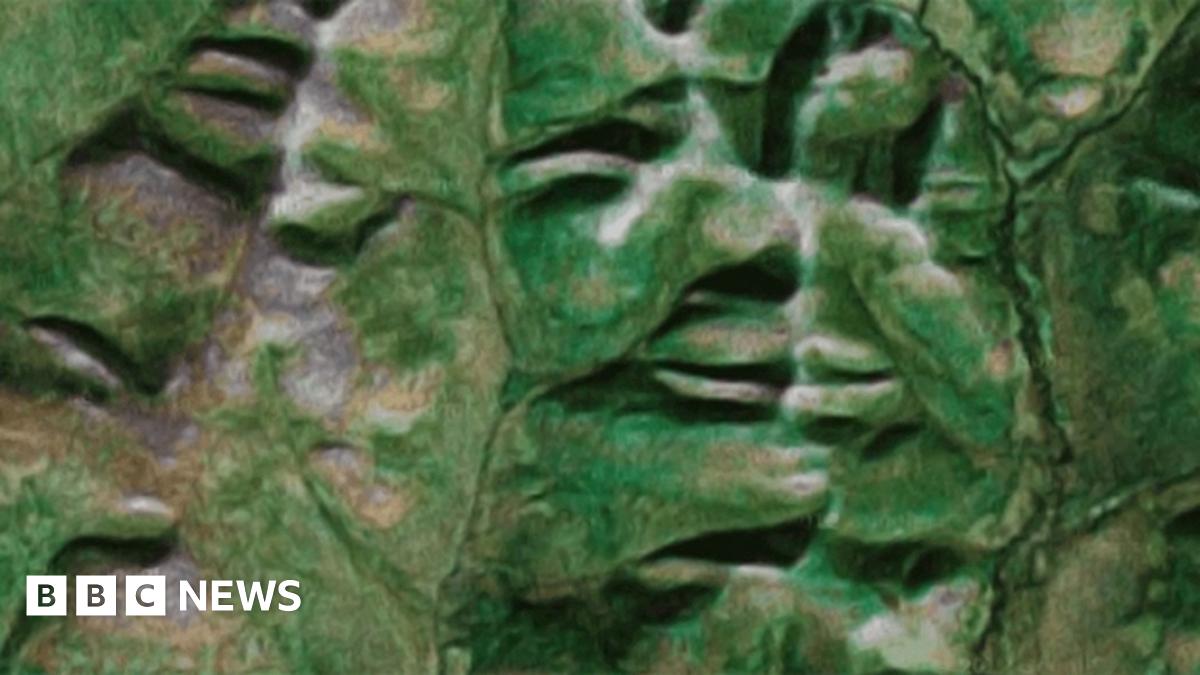The Zen of Technology & Scientific Discovery! (& Robots)
Collapse
X
-
Wonderful. Delightful.
Thank you!
Gassho
krissy
satThank you for teaching me.
I am very much a beginner and appreciate any words you may give me.Comment
-
Wait a second, I posted this a few days ago ...
NASA is showing you the picture the Hubble Space Telescope took on your birthday
So, what do you see there, old crone or young woman? I'm just sayin ...

Or maybe ... a miracle?

Just sayin ...

Actually, there is serious science here ...
Pareidolia: The science behind seeing faces in everyday objects. Ever tried to look for shapes in clouds, or seen a face burned into your toast? Pareidolia is a psychological phenomenon that causes people to see patterns in a random stimulus.
 A group plans to scour the planet via satellite imagery for human-like features. Why do we see faces in our surroundings?
A group plans to scour the planet via satellite imagery for human-like features. Why do we see faces in our surroundings?
Gassho, J
STLahLast edited by Jundo; 06-05-2020, 05:18 AM.ALL OF LIFE IS OUR TEMPLEComment
-
A signal from a distant civilization ... or just a black hole with the hiccups? ...
Well, maybe the black hole just ate a bad planet.Another mysterious radio burst in space is repeating a pattern. This one occurs every 157 days
For the second time ever, astronomers have detected a pattern in a mysterious fast radio burst coming from space.
Fast radio bursts, or FRBs, are millisecond-long bursts of radio waves in space, and astronomers have been able to trace some radio bursts back to their home galaxies.
They have yet to determine the actual cause of the bursts.
Individual radio bursts emit once and don't repeat. But repeating fast radio bursts are known to send out short, energetic radio waves multiple times.
Previous observations showed that usually when they repeat, it's sporadic or in a cluster.
That all changed earlier this year when astronomers found that FRB 180916.J0158+65 had a pattern in bursts occurring every 16.35 days. Over the course of four days, the signal would release a burst or two each hour. Then, it would go silent for another 12 days.
Now, they have detected a pattern in a second repeating fast radio burst, known as FRB 121102. During this cyclical pattern, radio bursts are emitted during a 90-day window, followed by a silent period of 67 days. This pattern repeats every 157 days.
 Another mysterious radio burst in space is repeating a pattern. This one occurs every 157 days | CNNFor the second time, astronomers have detected a pattern in a mysterious fast radio burst coming from space. It repeats every 157 days and originates in a dwarf galaxy over 3 billion light-years away. FRBs are millisecond-long bursts of radio waves in space.
Another mysterious radio burst in space is repeating a pattern. This one occurs every 157 days | CNNFor the second time, astronomers have detected a pattern in a mysterious fast radio burst coming from space. It repeats every 157 days and originates in a dwarf galaxy over 3 billion light-years away. FRBs are millisecond-long bursts of radio waves in space.
Gassho, J
SatTodayLAHALL OF LIFE IS OUR TEMPLEComment
-
So it ain't just a race, nor just victory to the swiftest ...
But I am a little confused: Where do the other sperm come from other than the woman's choice of partner?A woman's eggs choose lucky sperm during last moments of conception, study finds
Human eggs appear to "choose" which sperm will become the lucky winner in conceiving a baby. "Human eggs release chemicals called chemoattractants, which leave a sort of chemical breadcrumb trail that sperm use to find unfertilized eggs," said study author John Fitzpatrick, an assistant professor in the department of zoology at Stockholm University in Sweden.
"What we didn't know until this study is those chemical breadcrumbs act differently on sperm from different males, in effect choosing which sperm is successful," Fitzpatrick added.
"What this is suggesting is that these fluids are giving females one extra chance — long after she's picked her partner — to bias the number of sperm that are going to be coming towards the eggs."
And here's the extraordinary finding: A woman's egg doesn't always agree with her choice of partner.
"We expected to see some sort of partner effect, but in half of the cases the eggs were attracting more sperm from a random male," Fitzpatrick said. "The most likely explanation for this is that these chemical signals allow females to choose males who are more genetically compatible."
What makes a partner genetically compatible? One of the driving factors for that, Fitzpatrick said, are a complex set of genes called the "major histocompatibility complex," or MHC for short.
"Basically what these genes are about is fighting infection, fighting diseases and helping our immune system do really well," he said. "The more diverse those genes are, the more diverse are the kinds of infections you can fight. And if your partner has a slightly different combination of these genes than you do, then you're going to produce offspring that can fight an even broader array of pathogens and diseases."
and
Frankly from what I recall, sounds about like the dating scene in microcosm!And because mammals, including humans, are programmed to give our offspring the best chance for survival, our bodies have developed all sorts of methods to reward the strongest, most diverse and compatible mate possible. Even the female reproductive tract is an obstacle course designed to weed out weaker, less acceptable suitors.
Reproductive tract fluids, for example, flow downwards, thus forcing sperm to swim upstream, much like salmon must do when they spawn. At the same time, Fitzgerald said, the female's immune system views sperm as a foreign invader, attacking those swimmers as if they were germs. Once past the obstacle of the cervix's muscular contractions, sperm must then choose and swim up one of two fallopian tubes — yet the egg only travels down one, leaving a "blind alley that they can go down where there's no payoff."
The journey is so arduous that of the tens of millions of sperm a male might deposit, "our best estimate is that only about 250 total sperm get to the site of fertilization where the egg is," Fitzgerald said.
"On top of all of that, only about 10% of the 250 sperm are able to fertilize at any given time — they sort of blink on and off in their capacity to fertilize eggs," he added."So of that 250, it's more like 20 or 30 cells that can actually fertilize an egg at any different time."
Finally, the egg can affect which sperm wins the race with the chemicals it releases in the follicular fluid that surrounds the egg. That's the part which contains the chemical breadcrumbs eggs use to attract and guide sperm to their goal. "And it's only in the last two centimeters between a sperm and the egg that these chemical signals matter since it's the final phase of this long journey where females continue weeding out less acceptable sperm," Fitzgerald said.
..."The idea that eggs are choosing sperm is really novel in human fertility," said senior author Daniel Brison, the scientific director of the department of reproductive medicine at Saint Mary's Hospital in the UK, which is part of the Manchester University NHS Foundation Trust.
https://us.cnn.com/2020/06/09/health...ess/index.html
However, one more reason to realize how amazing it it that you, dear reader, are here at all to read this.
Gassho, J
STLahALL OF LIFE IS OUR TEMPLEComment
-
It matters.
Gassho, JExotic fifth state of matter made on the International Space Station
AN EXOTIC fifth type of matter has been created in one of the coldest places in the universe – a device on board the International Space Station (ISS).
The Cold Atom Laboratory (CAL) was launched to the ISS in 2018 to investigate a strange kind of matter, known as a Bose-Einstein condensate (BEC). This suitcase-sized device chills atoms of rubidium and potassium in a vacuum chamber, using laser light to slow their movement. Magnetic fields then contain the resulting cloud of atoms, which is cooled to nearly absolute zero at -273°C, producing a BEC.
This chilly substance was initially theorised by Albert Einstein and Satyendra Nath Bose in the early 1920s as the fifth state of matter, following solids, liquids, gases and plasma. It is a supercooled gas that no longer behaves as individual atoms and particles, but rather an entity in a single quantum state.
“This is pretty remarkable because this gives you a macroscopic-sized quantum mechanical object,” says Maike Lachmann at Leibniz University Hannover in Germany.
BECs have been produced in a variety of experiments on Earth since 1995, but these are hindered by gravity, which collapses the clouds in a split second. The microgravity environment of the ISS keeps them stable for multiple seconds, allowing them to be studied in more detail.
Read more: https://www.newscientist.com/article...#ixzz6P9c6DQHQ
STLahALL OF LIFE IS OUR TEMPLEComment
-
I'm too "dense" to understand this "top" story ...
Gassho, JRare quadruplet 'top quarks' created at world's largest atom smasher
Birth of these chubby-but-tiny particles could be a sign of new physics.
The world's largest atom smasher has "given birth" to a set of four ultraheavy particles — called top quarks.
The formation of these chubby-but-tiny quadruplets, at the Large Hadron Collider in Geneva, Switzerland, has long been predicted by the Standard Model, the prevailing physics theory that governs subatomic interactions. But new physics theories suggest they could be created much more often than the Standard Model predicts. Finding more of such foursomes is the first step in testing those theories. The new findings were announced at the LHCP 2020 Conference.
Top quarks are the heaviest known fundamental subatomic particles, according to a study published in 2019 in the journal Physical Review D. Each top quark is roughly as massive as an atom of tungsten. Yet each top quark is much smaller than a proton, meaning that not only do top quarks hold the record for heaviest particle, they also are the densest form of mass known.
...
The high significance seen by ATLAS could be mere chance. Or, it could be an indication that four top quark production is more common than the Standard Model predicts, which could mean that this measurement is the first hint of some new and unexpected physics. "Additional data from the next LHC run — along with further developments of the analysis techniques employed — will improve the precision of this challenging measurement," the researchers said in a statement.
The LHC has been temporarily shut down since late 2018 for refurbishments, upgrades and maintenance. It is scheduled to resume operations in 2021, although it is unclear if the COVID-19 pandemic will affect the schedule.
https://www.livescience.com/four-top...-collider.html
stlahALL OF LIFE IS OUR TEMPLEComment
-
Oh, gee, I thought there were only 35.
Maybe it is good that we don't all get in touch right now. Maybe it is good that solar systems are so spaced apart. Let's see if we first work out some of our own problems, learn to survive without killing each other. Then, the Vulcans are welcome to come make first contact.
There could be 36 communicating intelligent civilizations in our galaxy, study says
Scientists have calculated that there could be a minimum of 36 active, communicating intelligent civilizations in our Milky Way galaxy, according to a new study. However, due to time and distance, we may never actually know if they exist or ever existed. The study published Monday in The Astrophysical Journal.
Previous calculations along these lines have been based on the Drake equation, which was written by astronomer and astrophysicist Frank Drake in 1961. ... "The key difference between our calculation and previous ones based on the Drake equation is that we make very simple assumptions about how life developed," said study coauthor Christopher Conselice, a professor of astrophysics at the University of Nottingham, in an email to CNN. ... They developed what they call the Astrobiological Copernican Principle to establish weak and strong limits on life in the galaxy. These equations include the history of star formation in our galaxy and the ages of stars, the metal content of the stars and the likelihood of stars hosting Earth-like planets in their habitable zones where life could form. The habitable zone is the right distance from a star, not too hot or too cold, where liquid water and life as we know it may be possible on the surface of a planet. Of these factors, habitable zones are critical, but orbiting a quiet, stable star for billions of years may be the most critical, Conselice said.
... The Astrobiological Copernican Strong limit is that life must form between 4.5 to 5.5 billion years, as on Earth, while the weak limit is that a planet takes at least 4 billion years to form life, but it can form anytime after that, the researchers said.
... Even though this study only looked at our galaxy, distance is an inhibiting factor. The researchers calculated that the average distance between these potential civilizations would equal about 17,000 light-years. Detecting those signals or sending communications using current technology would take so long that it would be nearly impossible. "The search for intelligent life is only expected to yield a positive observation if the average life-span of [communicating extra-terrestrial intelligence] within our Galaxy is 3,060 years. That is to say, our communicating civilization here on Earth will need to persist for 6,120 years beyond the advent of long-range radio technology (approximately 100 years ago) before we can expect a [search for extra-terrestrial intelligence] two-way communication."
... Under the more relaxed assumptions of the Weak Copernican case, there would be a minimum of 928 civilizations communicating in our galaxy today, according to the study, meaning more of them at closer range. This would only require about 700 years to make a detection.
... If the search for this life reveals nothing within a distance of 7,000 light-years, the researchers suggest that this could mean one of two things. First, it could suggest that the lifetimes of these civilizations are shorter than 2,000 years — which could mean that our own is nearing its end. Second, it could suggest that life on Earth is unique and occurs in a much more random process than the Astrobiological Copernican Limits established in the study.
From "Hitchhiker's Guide to the Galaxy" ...


Gassho, J
STLahLast edited by Jundo; 06-16-2020, 01:59 AM.ALL OF LIFE IS OUR TEMPLEComment
-
Neil Harbisson was born with achromatism, or total colorblindness. In 2004, he had an antenna implanted into his skull that allows him to perceive colors as audible vibrations.Transhumanism: Meet the cyborgs and biohackers redefining beauty
As biotechnology advances, so too may our ideas of what it means to be human.
Today, we can alter our bodies in previously unimaginable ways, whether that's implanting microchips, fitting advanced prosthetic limbs or even designing entirely new senses.
So-called transhumanists -- people who seek to improve their biology by enhancing their bodies with technology -- believe that our natural condition inhibits our experience of the world, and that we can transcend our current capabilities through science.
...
"Beauty is in the engineered products," said Vintiner, who has spent years photographing real-life cyborgs and body-modifiers for his upcoming book, "I Want to Believe -- An Exploration of Transhumanism." ...
... One of Vintiner's subjects, James Young, turned to bionics after losing his arm and leg in an accident in 2012. Young had always been interested in biotechnology and was particularly drawn to the aesthetics of science fiction. Visualizing how his body could be "re-built," or even perform enhanced tasks with the help of the latest technology, became part of his recovery process. But according to the 29-year-old, the options presented to him by doctors were far from exciting -- standard-issue steel bionic limbs with flesh-colored silicone sleeves. ... Japanese gaming giant Konami worked with prosthetics sculptor Sophie de Oliveira Barata to design a set of bionic limbs for Young. The result was an arm and leg made from gray carbon fiber -- an aesthetic partly inspired by Konami's "Metal Gear Solid," one of the then-22-year-old's favorite video games.

James Young's arm is controlled by sensors that detect the minute muscle movements in his spine.

Describing himself as an "eyeborg," Rob Spence installed a wireless video camera in place of his right eye.

Maybe it is best that the other space civilizations leave us alone for awhile, until we work this out too.
Gassho, J
STLahALL OF LIFE IS OUR TEMPLEComment
-
Okay, maybe geology ain't quite as glitzy as space aliens and bio-implants ...
... still, we would not be here without ground to walk on and the earth's core ...
Do you think that's where the underground mole people live??Underground 'structures' discovered near Earth’s core, surprising scientists
Scientists have discovered “unexpected widespread structures” near Earth’s core.
Researchers analyzed thousands of recordings of seismic waves, or sound waves traveling through the Earth. Echoes from the boundary between Earth’s molten core and the solid mantle layer above it led to the discovery. “The echoes revealed more widespread, heterogenous structures—areas of unusually dense, hot rock—at the core-mantle boundary than previously known,” said the University of Maryland, which participated in the research, in a statement.
The study is published in the journal Science
... The structures lie 1,802 miles below Earth’s surface ...
https://www.foxnews.com/science/unde...ing-scientists
Gassho, J
STLahALL OF LIFE IS OUR TEMPLEComment
-
Saving the oceans ... or saving the sushi restaurants ... or both?
Really, who needs men? Maybe, who needs women too?Japan team uses stem cells to spawn 1,700 trout from single fish
A university team has succeeded in the first-ever mass proliferation of rainbow trout germ line stem cells (GSCs) in vitro, a technique that could pave the way for preservation of endangered fish and enable their mass production.
The team at Tokyo University of Marine Science and Technology spawned some 1,700 rainbow trout after producing sperm and eggs using GSCs from just one of its males, it wrote in the Monday edition of Communications Biology, a science magazine published by Nature Research.
... “We are also aiming to realize its application to bluefin tuna within around five years,” he said.
https://www.japantimes.co.jp/news/20.../#.XuhNQEUzaHs
This one takes about a minute to get going, but is pretty good too ... from 1:00 ...
Gassho, J
STLahLast edited by Jundo; 06-16-2020, 05:03 AM.ALL OF LIFE IS OUR TEMPLEComment
-
They say it went extinct 500 million years ago, but I am sure I saw this walking around my kitchen last night ...
"Each of its 54 legs had up to 15 daggers." The Buddha teaches non-violence. Nature, however, often has other things in mind.Ancient Cambrian shrimp with dozens of dagger legs looked unlike anything alive today
About 518 million years ago, a fierce shrimp-like creature didn't brandish just one "knife," it flashed more than 800 of them; each of its 54 legs had up to 15 dagger-like spines on it, a new study finds.
The name of this newly discovered Cambrian period scavenger, Xiaocaris luoi, literally means "Luo's small shrimp" — and it was small, just 0.8 inches (2 centimeters) long — but its vicious weapons likely meant that its mealtimes were filled with frenzied cutting, the researchers said. ... "The ecology of its limbs does suggest that it was probably shredding on some smaller organic matter" and soft animal remains, such as worms, on the seafloor. ...
... "[It's] a small, ancient relative of the spiders, centipedes, shrimps and insects of today, but with a lot more legs than one would expect for an arthropod," Liu told Live Science in an email. "Normally, an arthropod has only one pair of legs per trunk segment — millipedes of today have two pairs, but the 518 million-year-old Xiaocaris luoi has four."
https://www.livescience.com/cambrian...h-daggers.html

Gassho, J
STLahALL OF LIFE IS OUR TEMPLEComment
-
We found em!
If only we knew for sure that they are actually there ... or actually what they do!
Well, that's something! (Unless it turns out to be nothing!BREAKING: Physicists announce first direct evidence for 'axions'
A team of physicists has made what might be the first-ever detection of an axion.
Axions are unconfirmed, hypothetical ultralight particles from beyond the Standard Model of particle physics, which describes the behavior of subatomic particles. Theoretical physicists first proposed the existence of axions in the 1970s in order to resolve problems in the math governing the strong force, which binds particles called quarks together. But axions have since become a popular explanation for dark matter, the mysterious substance that makes up 85% of the mass of the universe, yet emits no light.
If confirmed, it's not yet certain whether these axions would in fact fix the asymmetries in the strong force. And they wouldn't explain most of the missing mass in the universe, said Kai Martens, a physicist at the University of Tokyo who worked on the experiment. ... And it's not certain that axions were detected at all. Despite two years of data collection, the hint of a signal is still faint compared to what physics requires to announce the discovery of a new particle. Over time, as more data comes in, Martens told Live Science, it's still possible that the evidence of a signal may fade away to nothing.
 )
)
I thought it was just for washing fry pans!

Gassho, J
STLahALL OF LIFE IS OUR TEMPLEComment








Comment